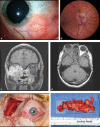Not a Tumor-Nonspecific Orbital Inflammation
- PMID: 33777622
- PMCID: PMC7987399
- DOI: 10.1055/s-0040-1722636
Not a Tumor-Nonspecific Orbital Inflammation
Abstract
Objective This study was aimed to illustrate the features and complexities of nonspecific orbital inflammation via discussion of two representative cases. Design Present study is a retrospective case review. Setting The study was conducted at a tertiary care medical center. Participants Two patients with nonspecific orbital inflammation were participants of this retrospective study. Main Outcome Measures Outcome of the study was disease-free patients and off all medications. Results At follow-up, both patients are disease free and off all medications. Conclusion Surgery plays a diagnostic and therapeutic role. While the clinical subtype is important for differential diagnosis and symptomatic treatment, the histologic subtype is similarly important. For inflammatory dacryoadenitis, surgery can be therapeutic. For extensive granulomatosis with polyangiitis, debulking surgery may allow better penetration of medications, especially rituximab.
Keywords: dacryoadenitis; granulomatosis with polyangiitis; inflammation; orbit; orbital pseudotumor.
Thieme. All rights reserved.
Conflict of interest statement
Conflict of Interest None declared.
Figures


Similar articles
-
Relationship between dacryoadenitis subtype of idiopathic orbital inflammatory pseudotumor and paranasal sinusitis.Int J Ophthalmol. 2016 Mar 18;9(3):444-7. doi: 10.18240/ijo.2016.03.21. eCollection 2016. Int J Ophthalmol. 2016. PMID: 27158618 Free PMC article.
-
Gene Expression Profiling and Heterogeneity of Nonspecific Orbital Inflammation Affecting the Lacrimal Gland.JAMA Ophthalmol. 2017 Nov 1;135(11):1156-1162. doi: 10.1001/jamaophthalmol.2017.3458. JAMA Ophthalmol. 2017. PMID: 28975236 Free PMC article.
-
Orbital Granulomatosis With Polyangiitis Mimicking IgG4-Related Disease in a 12-Year-Old Male.Int J Surg Pathol. 2018 Aug;26(5):453-458. doi: 10.1177/1066896917754252. Epub 2018 Jan 25. Int J Surg Pathol. 2018. PMID: 29366363
-
Orbital inflammatory disease: Pictorial review and differential diagnosis.World J Radiol. 2014 Apr 28;6(4):106-15. doi: 10.4329/wjr.v6.i4.106. World J Radiol. 2014. PMID: 24778772 Free PMC article. Review.
-
Orbital granulomatosis with polyangiitis (Wegener granulomatosis): clinical and pathologic findings.Arch Pathol Lab Med. 2014 Aug;138(8):1110-4. doi: 10.5858/arpa.2013-0006-RS. Arch Pathol Lab Med. 2014. PMID: 25076302 Free PMC article. Review.
Cited by
-
Deciphering the role of HLF in idiopathic orbital inflammation: integrative analysis via bioinformatics and machine learning techniques.Sci Rep. 2024 Aug 20;14(1):19346. doi: 10.1038/s41598-024-68890-x. Sci Rep. 2024. PMID: 39164324 Free PMC article.
-
Integrated machine learning and Mendelian randomization reveal PALMD as a prognostic biomarker for nonspecific orbital inflammation.Sci Rep. 2024 Oct 14;14(1):24020. doi: 10.1038/s41598-024-74409-1. Sci Rep. 2024. PMID: 39402101 Free PMC article.
-
Glutamine metabolism-related genes and immunotherapy in nonspecific orbital inflammation were validated using bioinformatics and machine learning.BMC Genomics. 2024 Jan 17;25(1):71. doi: 10.1186/s12864-023-09946-6. BMC Genomics. 2024. PMID: 38233749 Free PMC article.
-
Gluconeogenesis related gene signatures as biomarkers for nonspecific orbital inflammation.Sci Rep. 2025 Jul 1;15(1):20819. doi: 10.1038/s41598-025-05002-3. Sci Rep. 2025. PMID: 40595959 Free PMC article.
-
The roles of IRF8 in nonspecific orbital inflammation: an integrated analysis by bioinformatics and machine learning.J Ophthalmic Inflamm Infect. 2024 Jun 20;14(1):29. doi: 10.1186/s12348-024-00410-4. J Ophthalmic Inflamm Infect. 2024. PMID: 38900395 Free PMC article.
References
-
- Birch-Hirschfeld A. 2nd ed. Berlin, Germany: Springer-Verlag; 1930. Handbuch der Gesamten Augenheilkunden: Die Krankheiten der Orbita.
-
- Jakobiec F A, Font R L. Philadelphia, PA: W.B. Saunders; 1986. Orbit; pp. 2777–2795.
-
- Nugent R A, Rootman J, Robertson W D, Lapointe J S, Harrison P B. Acute orbital pseudotumors: classification and CT features. AJR Am J Roentgenol. 1981;137(05):957–962. - PubMed
-
- Kennerdell J S, Dresner S C. The nonspecific orbital inflammatory syndromes. Surv Ophthalmol. 1984;29(02):93–103. - PubMed
-
- Mahr M A, Salomao D R, Garrity J A. Inflammatory orbital pseudotumor with extension beyond the orbit. Am J Ophthalmol. 2004;138(03):396–400. - PubMed
LinkOut - more resources
Full Text Sources
Other Literature Sources

